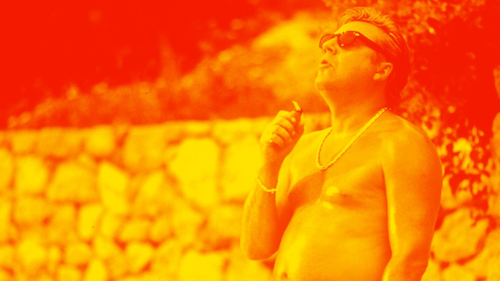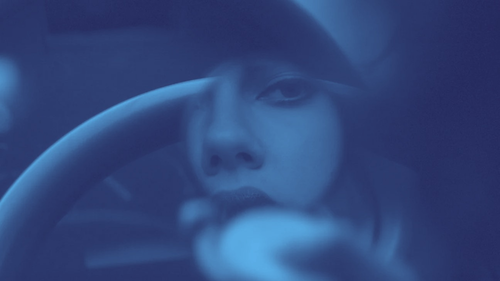Filmography Worship: Ranking Every Jonathan Glazer Film
Written by Andreas Babiolakis
Filmography Worship is a series where we review every single feature of filmmakers who have made our Wall of Directors (and other greats)
Jonathan Glazer has quickly become one of the most singular filmmakers of the twenty-first century. Known for his feature films that function more as experiences than clear-cut stories (although they deceptively possess these as well), Glazer has a small-but-mighty filmography that feels equal parts Kubrick, Bergman, and Tarkovsky in their ambition, artistry, and effectiveness. It’s no secret that the London director worked small before he went large, with some background in music videos and an even more extensive career in advertisements (in regards to the former, Glazer is easily one of the finest music video directors of all time with a handful of entries being arguably the best of the medium). This exposure is important when looking at his feature films because each one feels like a short story concept or idea elongated to over an hour in length, and yet Glazer is so assured in his capabilities that these films never overstay their welcome; if anything, his films average one hundred minutes in length (!) and have never surpassed even the two-hour mark. Even though his films feel like they possess an endlessness to them, Glazer clearly understands conciseness and the art of showing only what is necessary.
It feels a little cheap to say this considering how small Glazer’s filmography is (if Sexy Beast was released in 1999 instead of 2000, he’d be averaging one feature film a decade), but I wouldn’t consider any of his films to be anything short of great. He is that consistent. Despite how long we have to wait in between each Glazer project, it’s comforting knowing that he has never failed with any of his films. Every film provides us with an entry into a world or reality we will never personally understand ourselves, and yet we exit with what feels like a complete comprehension of what we have just seen. Glazer is generally a master of the coveted rule of visual storytelling (show, don’t tell), so we feel his films as opposed to watching them. Even still, his films are packed with aesthetic and technical splendour, with keen cinematography and an affinity for editing precision (likely two traits he picked up during his days as a prolific music video director).
Glazer’s films exemplify guilt, the inner turmoil of split decisions, and visceral, moral-based regret. All of his features showcase protagonists that seemingly follow the course of where the wind takes them, and yet we understand that they are actually calculating their own paths only to be forced to face their poorest versions of themselves, either through karma-based ruin or even a slight realization as to what they have done. Let’s not dilly-dally anymore. This will be a shorter list given the size of Glazer’s filmography, so I have tossed in a special bonus of sorts afterward that you can look forward to. It’s time to hop into what is essentially a perfect run by a magnificent auteur. Here are the feature films of Jonathan Glazer ranked from worst to best. Be sure to keep an eye out for what is likely an obvious running theme with how these films are ranked.
4. Sexy Beast
While Sexy Beast feels a bit like an outlier, it’s clearly a feature film debut by a director who was figuring out what kinds of projects he wanted to take on. This crime drama goes heavily against what Glazer would be known for (sparse dialogue, heavy minimalism, and slow, ethereal shots) by possessing machine gun rambling and a blaze of cuts (although the editing is as sharp as it has ever been in Glazer’s films). While Sexy Beast feels like a whole lot of nothing for two-thirds, it’s secretly a ticking time bomb waiting to go off precisely when Glazer needs it to; while we enjoy how hilariously evil and angry the magnificent performance of Don Logan by Ben Kingsley is, once he finally snaps, it is clear we ignored far too many warning shots. Even still there are hints of where Glazer would venture next as a filmmaker, including the demonic dreams that protagonist Gal Dove experiences (mirroring the kind of imagery Glazer was known for in his music videos) and the minimal use of settings, characters, and circumstances to tell impactful, shocking stories. I do love Sexy Beast, odd title and all. It’s ranked last just because one film had to be. I think it’s one of the better gritty, foul-mouthed crime films to come after Quentin Tarantino’s rise to fame (with many pale imitators in his wake), and even still Glazer is clearly adopting his own style here. Sexy Beast is a strong, exhilarating start but it would only be the tip of the iceberg for what is to come.
3. Birth
If there is any film that must be reassessed via a modern understanding of cinema, Glazer’s Birth has to be this film. One of the most grossly underrated films of the new millennium, this tragic look at grief and loss is one of the best Ingmar Bergman films that the Swedish legend never made. Maybe Glazer got too ahead of himself after Sexy Beast when making Birth because this is clearly a film that would have been received much better ten years later because of its brooding, empty, frigid, nihilistic tone. Glazer was also getting more into his signature style here to full effect, with lingering shots, quietness being used effectively, cold environments, dialogue, and visuals, and storytelling that forces you to do much of the heavy lifting (as to create your own personal connection with the film). I understand how Birth could have been viewed as perverse upon its release given its premise (a widow believing her deceased husband has been reincarnated as a young boy who is trying to stop her wedding with a new man), particularly the infamous bathtub sequence, but I feel like the film and especially this scene are misunderstood; viewing Birth in a literal sense is to ignore the metaphor of how the death of a loved one plagues the living forever. As someone who has experienced the weight of grief firsthand this year, Birth makes complete sense to me: the extent we take to try and bring back the dearly departed into our lives. While I don’t think most people would go to the lengths that protagonist Anna does here, Glazer is taking us to the utmost outskirts of sanity in the name of trauma. No one will ever fully be able to process the death of a loved one, and Birth represents this agony better than most films on the subject.
2. Under the Skin
Glazer proceeded to venture deeper and deeper into minimalist, ambient storytelling when he blessed us with the eerie, horrifying science fiction poem Under the Skin: one of the great films of the genre this century. As we silently follow an alien life-form that inhabits the persona of a human being and lures people — specifically horny alpha males — in order to harvest their skin. The mysteriousness of this vast cinematic void encourages you to try and piece together what is transpiring on screen up to its monumental, painfully gorgeous (yet petrifying) climax. Once Under the Skin is done, you’ll be pressed to rewatch it repeatedly, learning more about what is actually going on in this deceptively deep film. It features the breakthrough score by one of my all-time favourite cinematic composers Mica Levi (whose music here is made up of beautifully nauseating and unsettling experimental, industrial tremors); this first effort has already been celebrated as an instant classic. An aesthetic, austere, anguishing affair, Under the Skin has only grown stronger with time since its release; it feels like staring into the abyss and discovering the horrors and allurement of the unknown. Its commentary on objectification, self-sabotage, the search of identity, and how alien our world truly is is astounding.
1. The Zone of Interest
There were talks about The Zone of Interest for years after Under the Skin sunk itself into the souls of audiences around the world for years. The wait for this Holocaust drama did not disappoint whatsoever. Taking the concept of comfortable living for Nazis outside of the Auschwitz concentration camp and focusing on the corrupted compliance that is necessary to have this life of luxury, Glazer provides one of the most unsettling cinematic experiences of the new millennium (even perhaps ever). With impeccable editing that renders audiences a ghostly presence (by making each shot and angle feel so fluid in an omnipresent way) that scrutinizes a culpable family during their everyday activities, The Zone of Interest is an exercise in us being unable to do anything while this featured Nazi family are in control of every move they make. Certainly a challenging film, it is virtually impossible to watch The Zone of Interest without being shaken to your core. It quickly became one of the greatest films of the 2020s decade to me and has been a feature film I’ve been unable to forget since I first saw it: this is maximalist minimalism at its finest, and an exposition of the weight of even the smallest details and choices in guilt-laden lives. As it stands right now, this is the greatest film Jonathan Glazer has ever directed.
Bonus: Ranking Jonathan Glazer’s Music Videos
I felt like the filmography ranking was quite short (and, in case you didn’t already pick up on it, the ranking was in the order of when these Jonathan Glazer films got released, so I clearly think he’s only getting better and better, but that also doesn’t make for interesting content). To try and give you something extra to make your visit here worthwhile, I’ve decided to take the ten music videos Glazer directed and rank those too (I’m excluding whatever projects were cancelled, because, well, they just don’t exist).
10. A Song For The Lovers
This Richard Ashcroft solo song gets a peculiar music video that feels invasive and direct. While certainly not a bad video (I don’t think Glazer has been capable of bad thus far), I don’t think there’s nearly as much to cling onto here as there is in other Glazer-related videos. The song pauses and continues while Ashcroft undergoes various activities whilst stewing in loneliness in a hotel room, only for the big climax of the famed The Verve singer urinating in a toilet to cap things off. It’s an intriguing video but I don’t feel any major takeaways outside of the minutiae of the rockstar life while on tour.
9. Live With Me
Glazer doesn’t usually explore his comedic side, and we get a glimpse of that at the start of this Massive Attack cut (with an announcement for the video being cut short by an impromptu act of choking). As if that opening came from a completely different realm, we dive into a night with a woman (played by Kristy Shepheard) battling her addictions; this voyeuristic video feels like a precursor to what we’d get in Under the Skin. While this unknown woman goes on a bender, she concludes the video seemingly in a state of bliss at the end of a literal downward spiral (having fallen down a spiral staircase at high speed). An interesting narrative but a message that’s just a constant without much else to say, “Live With Me”’s video only gets so far despite being quite haunting as is.
This alternative version of “Live With Me” also exists, and while it’s simply just an extreme close-up of the late Terry Callier singing the song, it somehow resonates with me more; perhaps the candidness of such a vulnerable video and song being paired together works better for me. Even though I’m just tossing it in here, I’d rank it just one spot over the official “Live With Me” video so this ranking won’t be any different than it currently is.
8. Karmacoma
The better of the two Massive Attack videos Glazer directed (I’m not sure why the official YouTube upload by Massive Attack has it listed as a Michel Gondry project), “Karmacoma” is stuffed with cinematic references from The Shining to Pulp Fiction (see? I was right about what I said when covering Sexy Beast’s connection to Tarantino). There’s a clear yet abstract story going on here involving criminals being represented via cryptic vignettes on a single hotel floor and within its many rooms (we find out that this one character who stares off into the distance throughout the whole video is responsible for having killed them all, and the video acts as his way of cleansing his soul of guilt). Simple yet expansive with its creepy creativity, “Karmacoma” is spooky and fascinating all around.
7. Treat Me Like Your Mother
The Dead Weather’s two lead vocalists Alison Mosshart and Jack White destroy the notion of high noon in Glazer’s campy, invincible take on a tired trope of the Western genre. As they continuously shoot at each other and ramp up the damage without dying, the ridiculousness of this situation turns into superhero dominance as two powerhouses riddle one another with bullets and flying shells. As they go back and forth with their calls and responses, it’s clear that this is a playfully badass take on the concept of two acclaimed singers fronting a rock and roll supergroup, and Glazer’s action-filled bonanza can be the only visuals appropriate for such a song. We don’t see Glazer’s silly side too often, but this is one of his finer cases of being fun.
6. Into My Arms
While a simple video of Nick Cave singing with the shadows of emptiness devouring him, “Into My Arms” is highly effective. We get cuts to all walks of life going through their own tribulations as if Cave’s song is applicable to them as well (and to you, the viewer). Glazer fulfils Cave’s quest to make this an anthem for anyone who needs it with this stripped-down take on introspective reflection. The video has sadly aged tremendously given the numerous tragedies Cave has experienced as of late, including the shocking deaths of two of his children, and both the song and visual accompaniment take on a whole new life as a result: a safe space for aching hearts and lost souls to find peace.
5. The Universal
Glazer places the pretty boys of Blur into Stanley Kubrick’s A Clockwork Orange for an exquisitely uncanny video for “The Universal”, and while a tribute would have likely been interesting enough, this video is unquestionably an exhibition of how well Glazer understands Kubrick as an auteur and how his films tick. This goes beyond even just a sense of mimicry: Glazer turns the Korova Milk Bar into his own playground to explore his version of the notorious cult classic. The cinematic passion matches Blur’s triumphant song, as both elevate each other to glorious yet cheeky exaltation: here’s an homage that thrives on its own and feels prominent within both Glazer and Blur’s careers.
4. Street Spirit (Fade Out)
Glazer takes this Radiohead gem and places an unfortunate death underneath the guitar arpeggios. We are graced with both nightmarish and dreamy images as if we are getting a cryptic dance instead of a literal life flashing before our eyes. As a dying soul (Thom Yorke is sadly the guinea pig here for this role) struggles to cope with his fate, we are presented with Glazer’s most surreal, inexplicable sequences to date: a tango with death, rebirth, fear, and comfort. Finally, Yorke elevates as if he is at peace with what has happened, and the video cuts before we see where he is ascending to; this video is limbo personified in Glazer’s signature style. Not that any of us living mortals know what the “other side” (or the bridge to get there) looks like, but somehow Glazer seems to have nailed what I can only imagine it would be like.
3. Virtual Insanity
Possibly Glazer’s most simple music video conceptually, it is still his most impressive on a technical level. Jamiroquai singer Jay Kay makes the most of a small, white room and dances his way around the shifting furniture and the moving floor. With only a few startling cuts that pan to surprising images before we return to the crux of this video, “Virtual Insanity” is as plain as can be. Sometimes, that’s all a music video needs to be. We don’t get a story, but we do get a vibe, and I don’t think you can ever hear this song the same way ever again; what other images will you conjure up in your mind outside of this? Glazer’s iconic music video is mesmerizing to start; you will find yourself unable to break the trance of this remarkably infectious, choreographically magnificent visual.
2. Karma Police
Have you ever been egged on to do something wrong? Glazer takes Radiohead’s commentary from their smash hit “Karma Police” to quite a literal level as we join Thom Yorke in a car and chase down a fugitive in the middle of the night. Even just the static shot of the individual booking it on foot is so well shot that this alone serves as a tremendous visual for the song. Of course, Glazer goes further. We eventually catch up to the now-exhausted stranger as we are karma, and karma doesn’t wait for anyone. Well, the joke is on us when our bullying becomes our own karma-based curse, as the fugitive sets our car ablaze and punishes us for ruining his life; Yorke has left us to die on our own in this brilliant fable that embodies Glazer’s fascination with sinful decision making and the curse of regrets upon one’s deathbed.
1. Rabbit in your Headlights
We follow Denis Lavant through a tunnel as he faces both oncoming traffic and cars behind him. He murmurs a schizophrenic mantra under his breath while cars swerve around him until the game of chicken leans in favour of the vehicles and begins crashing into him. Lavant’s mysterious character keeps walking, ignoring the obstacles and punishments that life has been hurling his way. As U.N.K.L.E.’s song ascends (and guest singer Thom York, who just keeps popping up on this list, mourns our anguish), Lavant finally declares that he has had enough and rips off his coat, rendering himself more vulnerable than ever. In “Rabbit in Your Headlight”’s glorious final shot of perseverance and strength, we are left with a music video poem that has transcended time as one of the finest examples of the medium. You go through the motions with this video, feeling heavily depressed until you are presented with a release of euphoria for the pummelled stranger of whom you just want a better life. We feel ourselves in Lavant’s distress, and we empathetically experience his release when he finally triumphs over life’s tortures. It is a rarely optimistic moment in Jonathan Glazer’s career, but it took us being dragged through hell to get there; the entire trip is beyond worthwhile.
Andreas Babiolakis has a Masters degree in Film and Photography Preservation and Collections Management from Ryerson University, as well as a Bachelors degree in Cinema Studies from York University. His favourite times of year are the Criterion Collection flash sales and the annual Toronto International Film Festival.







